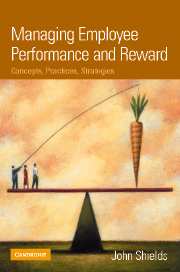Book contents
- Frontmatter
- Contents
- List of figures and tables
- Foreword by John Egan
- Acknowledgements
- Introduction: Setting the scene
- Part 1 The fundamentals
- Part 2 Performance management in action
- Part 3 Base pay and benefits
- 9 Base pay purpose and options
- 10 Base pay structures
- 11 Developing position-based base pay systems
- 12 Developing person-based base pay systems
- 13 Employee benefits
- Case study. Just rewards: Rethinking base pay and benefits at Court, Case & McGowan, commercial law partners
- Part 4 Rewarding employee performance
- Part 5 Fitting it all together
- Model responses to case studies
- References
- Index
Case study. Just rewards: Rethinking base pay and benefits at Court, Case & McGowan, commercial law partners
from Part 3 - Base pay and benefits
- Frontmatter
- Contents
- List of figures and tables
- Foreword by John Egan
- Acknowledgements
- Introduction: Setting the scene
- Part 1 The fundamentals
- Part 2 Performance management in action
- Part 3 Base pay and benefits
- 9 Base pay purpose and options
- 10 Base pay structures
- 11 Developing position-based base pay systems
- 12 Developing person-based base pay systems
- 13 Employee benefits
- Case study. Just rewards: Rethinking base pay and benefits at Court, Case & McGowan, commercial law partners
- Part 4 Rewarding employee performance
- Part 5 Fitting it all together
- Model responses to case studies
- References
- Index
Summary
You could have cut the conference room air with a knife. James Court, chief national partner of Sydney commercial law firm Court, Case & McGowan, had just delivered an address to the firm's 600 Sydney-based solicitors informing them that the previous financial year had been one of the firm's best profit-making years ever. For all of Court's upbeat assessment, his announcements showed remarkably poor judgement and timing. Just two weeks earlier, the firm had completed its annual pay reviews, which had resulted in increases lower than for any of the previous five years. As the caterers rolled out the post-address refreshments, many of the solicitors present muttered darkly to each other that the time and effort that they had put into achieving this outstanding financial result had not been adequately recognised or rewarded. Several 20-something high achievers who had put in long hours on difficult legal cases grumbled about leaving the firm (and possibly the legal profession altogether) to work for an organisation where their contribution would be far better rewarded. One of the firm's most successful female corporate tax lawyers spoke of going to work for a merchant bank renowned for the five-figure bonuses it paid to its commercial litigation team.
Such utterances do not bode well for Fiona Fenton, the firm's new director of human resources. Court had invited Fiona along to his address to introduce her to the firm's core workforce.
- Type
- Chapter
- Information
- Managing Employee Performance and RewardConcepts, Practices, Strategies, pp. 340 - 344Publisher: Cambridge University PressPrint publication year: 2007



